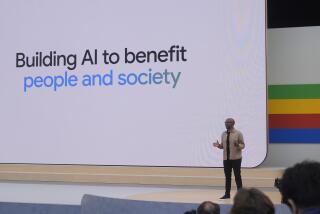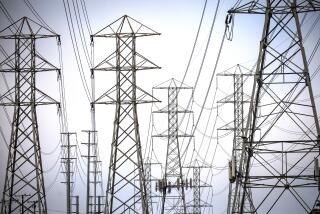Utility hopes program gives clear picture of smart-grid tech
A week ago, Jim Sepe began playing around with his appliances — turning up the air conditioner, setting the Jacuzzi at a lower temperature and running the microwave to watch numbers tick up and down on a digital photo frame he keeps on his kitchen countertop.
“It’s really fun,” Sepe said. “I learned that if I did this or that, or turned my Jacuzzi down a few degrees, I was saving money.”
Sepe is a guinea pig for a new project, cooked up by a Burbank businessman, Glendale Water & Power and Ceiva, a digital frame maker, that displays electricity and water usage on a small frame to get people to engage with the smart-grid technology the city has spent $20 million on.
Glendale was the first city in the nation to get federal stimulus money for installing smart-grid technology in March. The utility has installed about 75,000 of the smart meters, which have raised concerns over privacy and electromagnetic radiation exposure elsewhere in the state.
Utility providers throughout the country have spent millions on smart-grid technology but are having trouble getting customers to take advantage of it. Smart meters enable customers to track their energy use online and change their behavior in order to save money. But that happens only if people pay attention.
“I think [the frame] is going to revolutionize smart grid because … it’s going to get customers really engaged,” said Glenn Steiger, general manager of Glendale Water & Power. “That’s the point — people need to be engaged for it to work.”
Amid a slide show of Sepe’s family photos, a screen shows up notifying him that he’s spending 13 cents an hour on electricity and he’s used 640 gallons of water this month. When he flips on the air conditioner, the electricity cost shoots up to 94 cents an hour.
“I knew that when I turned on the A/C, it’s going to be more, but I didn’t know how much more,” said Sepe, Ceiva’s chief technology officer.
Since having the frame for about a week, Sepe said, it’s caused him to think more about how much he waters his lawn and about bringing down his Jacuzzi temperature when he’s not using it.
For 10 years, people have been able to send photos directly from phones or computers to Ceiva frames. The company reconfigured that wireless technology recently to connect for the first time with energy data, Ceiva President Dean Schiller said.
Schiller, who lives in Glendale, met Steiger a few months ago at a smart-grid conference in Washington, where several speakers talked about the challenge of getting customers to engage with smart-meter technology.
Smart meters have been a tough sell for some customers who loathe the Big Brother aspect of the technology.
“Everybody’s struggling with this issue and how to connect with the customer,” Schiller said. “We thought, ‘How do we get people’s energy data in front of them?’”
Ceiva plans to distribute 50 more of the frames in the next few months to Glendale Water & Power customers as part of a pilot program. Steiger said the city was looking for volunteers to check out the frames, which would be provided free.
“We want people who really want to participate,” Steiger said.
Participation elsewhere in the state has run into roadblocks.
In the San Francisco Bay Area, particularly Marin County, residents have protested Pacific Gas & Electric’s installation of the wireless meters, citing health, privacy and cost concerns.
The publicly owned utility has installed about 8 million meters, but the California Public Utilities Commission has asked it to devise a way for customers to opt out of the wireless technology. Only a small number of the Glendale utility’s customers have raised similar objections.
Levine writes for Times Community Newspapers
More to Read
Sign up for Essential California
The most important California stories and recommendations in your inbox every morning.
You may occasionally receive promotional content from the Los Angeles Times.










